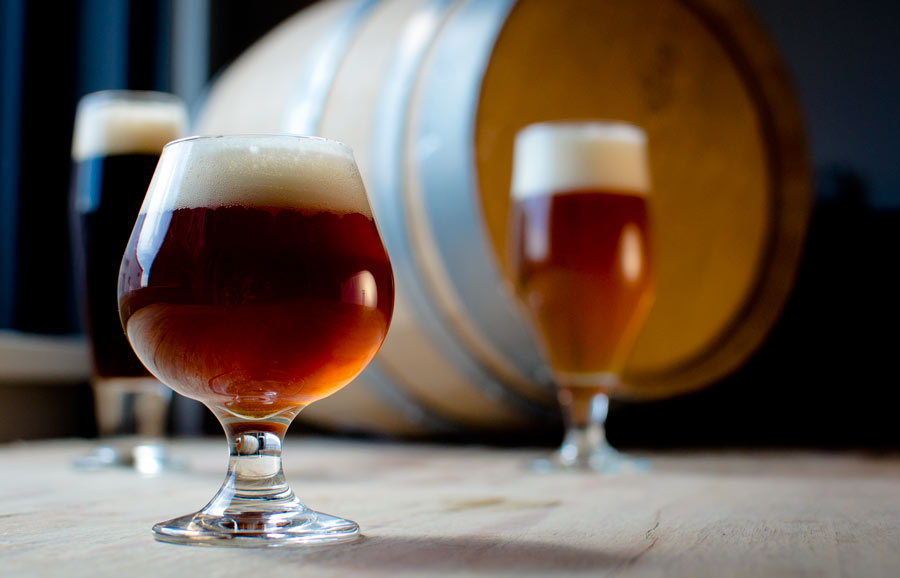No doubt, there are some who will take issue with my assertion that cask-conditioned ale is draught beer at its best. For some, it’s flat and lacks body. For others, it’s served too warm. Perhaps many naysayers have only been exposed to cask ale that has either been poorly casked or mishandled in transit.
If the beer is well-handled, fresh and properly dispensed, the subtle differences between cask beer as opposed to kegged can be profound. If it’s well done, I absolutely believe cask beer is draught beer at its best.
What is Cask Beer?
Unfiltered beer (usually ale), that is racked (transferred) into casks, krausened (carbonated), sealed and then undergoes a slight final fermentation in the cask. Often finings (clarifying agents) will be added to help the beer drop bright—when yeast cells naturally flocculate (clump) and settle at the bottom of a vessel.
(See some unfamiliar terms? Check out the Beer Dictionary & Glossary of Terms)
The net result is a beer that has a much gentler level of carbonation, a rounder mouthfeel, and since it is unfiltered, usually shows a slightly more complex flavor and aromatic profile. It is often slightly cloudy, and is best served at cellar temperature (around 55°F). It’s considered “live” beer since it is unfiltered and has live yeast in the cask (which is how we get the final fermentation and carbonation).
What Makes Cask Beer Different From Keg Beer?
Normal keg beer is filtered, carbonated to usually 2.4 volumes of CO2 and pushed out of the keg with CO2. Cask beer is dispensed traditionally (and preferably in my opinion) by being pumped out of the cask using what is called a beer engine (hand pump). Since there is no CO2 pushing the beer out of the vessel, air is allowed to enter the cask as the beer is dispensed.
This means that once tapped, the beer must be consumed fairly quickly (I prefer within 48 hours) before it will start to go completely flat and spoil. Also, unlike keg beer, cask ale is best served at 55°F. This temperature allows all of the flavor nuances to emerge and permits appreciation of the unfiltered texture.
Misunderstandings About Cask Beer
Cask beer is delicate and highly perishable. Consequently, if it is poorly casked or handled, there can be disappointing results. Usual complaints are the beer is totally flat, muddy in appearance or served too warm. Unfortunately for some folks, that is their only experience with cask beer, and that has led to some serious misunderstandings. Indeed, good cask ale should be neither flat, muddy or warm.
Serving Cask Beer
While the traditional method for dispensing cask beer is through a beer engine (hand pump), it can also be dispensed using a cask tap. This is literally a faucet that is hammered into the cask through the keystone (hence the term tapping a keg). Once tapped, the beer is dispensed by gravity. As the beer flows, air is allowed to enter through the spile (a small wooden peg used to control the flow of air into, and carbon dioxide out of a cask). I always prefer the beer engine, but the cask tap is okay for festivals and special events.
Cask Sizes
- Firkin | 10.8 gallons (by far the most popular size)
- Pin | 5.4 gallons
- Kilderkin | 21.6 gallons
Personal Preferences
I usually go for hoppy ales in cask format. We (Heavy Seas Beer) usually add extra dry hops to the casks that we make for our pale ale (Powder Monkey Pale Ale) and our IPA (Loose Cannon). Both of these show really well in this format, although the Powder Monkey—at about 4.7 percent ABV—is closer to what the English would call a session beer than the Loose Cannon, which clocks in at 7.25 percent ABV.
Finding Cask Beer
The usual suspects include pubs that claim a true British heritage or theme. They are more likely to know how to handle the beer and often have beer engines. There are also a growing number of cask-oriented festivals, which are a great opportunity to try a wide variety of cask ales and producers in one setting. I also suggest that folks seek out the top “beer geek” bars in their area while on the hunt for cask ales. These bars specialize in serving better beer and usually feature a rotation of cask offerings.
CraftBeer.com is fully dedicated to small and independent U.S. breweries. We are published by the Brewers Association, the not-for-profit trade group dedicated to promoting and protecting America’s small and independent craft brewers. Stories and opinions shared on CraftBeer.com do not imply endorsement by or positions taken by the Brewers Association or its members.

Share Post